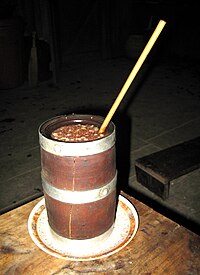Traditional alcoholic beverage of Gorkhas
1.Rakshi
Raksi (Nepali: रक्सी) or Rakshi is a traditional distilled alcoholic beverage of Gorkhas And Nepalese. It is often made at home.
Because of its popularity, there exist various temperance movements in Nepal, including various women's groups. Raksi, however, remains an important requirement of various religious rituals and social events, due in part perhaps to its antiseptic properties.
Serving
Raksi is often served in a bhatti glass and during special occasions, the drink is poured from a great height via a pitcher with a small spout, making an entertaining spectacle.Production
Raksi is produced, sold and mostly consumed at rustic distilleries scattered around the countryside. Usually it is not aged before consumption. A large amount of wood is used in the distillation process.2.Chhaang
Chhaang
Geographical prevalence
Chhaang is consumed by ethnically Nepalese and Tibetan people and, to a lesser degree, by the neighboring nations of India and Bhutan. It is usually drunk at room temperature in summer, but is often served piping-hot in brass bowls or wooden mugs when the weather is colder.Ingredients and drinking
Chhaang is a relative of beer. Barley, millet (finger-millet) or rice grains are used to brew the drink. Semi-fermented seeds of millet are served, stuffed in a barrel of bamboo called a dhungro. Boiling water is then poured in and sipped through a narrow-bore bamboo tube called a pipsing.When the boiled barley has cooled, some yeast or dried barm is added and it is left to stand for two or three days when fermentation begins; this concoction is called glum. The barm consists of flour and, in Balti, often has ginger and aconite added to it. After fermentation is complete, water is added to the brew and is then ready for consumption.
In Lahaul the glum is pressed out by hand instead of by filtering, yielding a rather cloudy drink. The residue of malt can be pressed through a strainer and then mixed with water or milk and used in baking bread or cakes.
Near Mt. Everest of Nepal, chhaang is made by passing hot water through fermenting barley, and is then served in a large pot and drunk through a wooden straw.
In Nepal, this beverage is called tongba by the Limbu,Rai,Gurung,magar..etc, or jand which refers to the turbid liquor obtained by leaching out the extract with water from the fermented mash. Unlike chhang or tongba, jand is served in large mugs. These alcoholic beverages are generated using a traditional starter called murcha. Murcha itself is prepared by using yeast and mold flora of wild herbs in cereal flours.
The brew tastes like ale. Alcohol content is quite low, but it produces an intense feeling of warmth and well-being, ideal for enduring the temperatures which go well below freezing in winter.
Myth
Chhaang is said to be the best remedy to ward off the severe cold of the mountains. It reputedly has many healing properties for conditions like the common cold, fevers, allergic rhinitis, and alcoholism among others.According to legend, chhaang is also popular with the Yeti, or Himalayan Snowmen, who often raid isolated mountain villages to drink it.
Social correlates
Drinking and making offerings of chhaang are part of many pan-Tibetan social and religious occasions, including settling disputes, welcoming guests, and wooing.3.Tongba
Preparation
Tongba actually is the vessel which holds the fermented alcoholic beverage known as Jaand. Jaand is prepared by cooking and fermenting whole grain millet. The cooked millet is cooled and mixed with murcha (which is a source of molds, bacteria and yeast). Then the mass is collected and placed in a woven bamboo basket lined with green leaves or plastic, covered with thick fold of cloth and allowed to remain in a warm place for 1–2 days depending upon the temperature. The sweet mass is then packed tightly into an earthenware pot or plastic jars and the opening is usually sealed off to prevent air from entering. After 7–15 days also depending upon the temperature, the fermentation is complete and the mass is converted to jaand.The time jaand is left to remain undisturbed in the pot after completion of fermentation leads to maturing of the jaand. During the maturing the flavours and taste intensifies yet become more mellowed. Traditionally it is stored for about six months.
It is consumed in a unique way: the fermented millet is put in a container, also traditionally called a Tongba, and boiled water is poured in it to the brim. It is then left undisturbed for about five minutes. Once the five minutes has passed it is ready to drink. A fine bamboo straw with a blind end, but perforated on the side to act as a filter, is inserted into the container to suck out the warm water and alcohol from the millet grains. More hot water is added as the tongba becomes dry, and the process is repeated until the alcohol is exhausted.

No comments:
Post a Comment